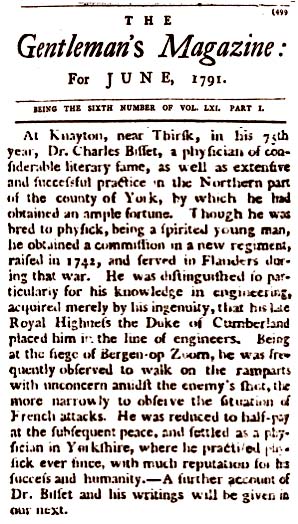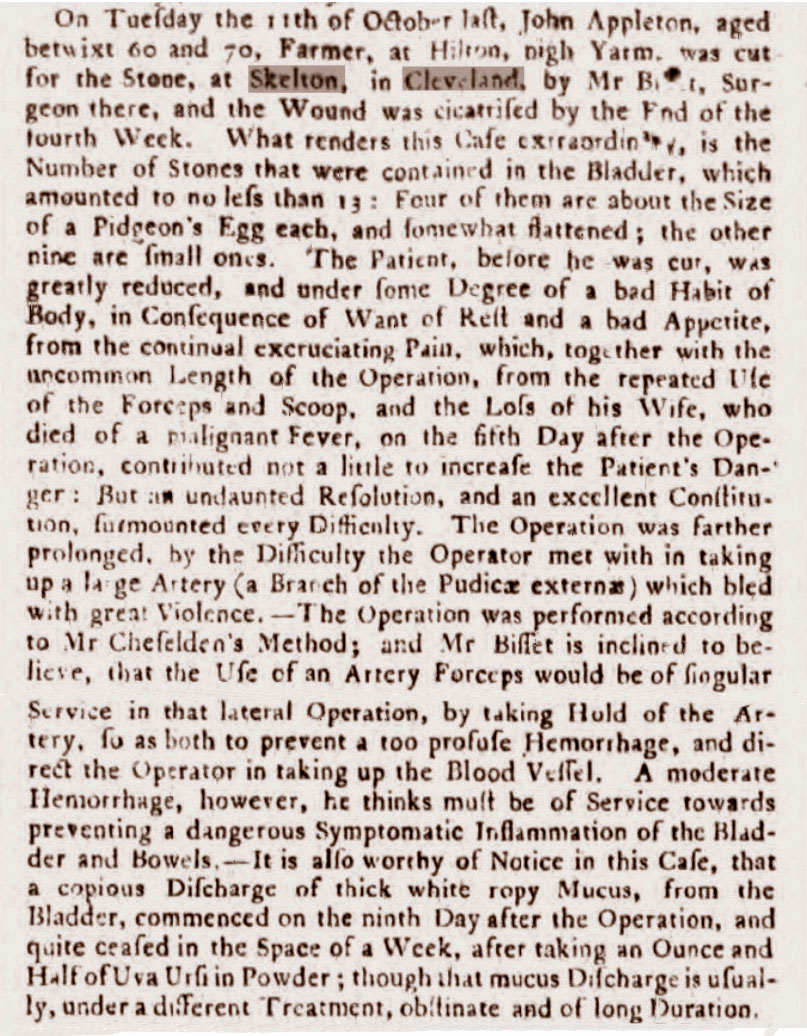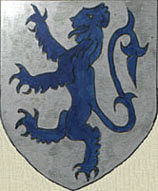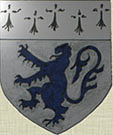Charles Bisset M.D.
Skelton's 18th Century Doctor and Military Engineer.
|

|
About 1750 there came to settle in Skelton in Cleveland a famous Scot, Dr Charles Bisset. M.D.
He chose this area, it is said, for the quality of its healthy air. He was just in his early thirties, but had already had an adventurous life.
At the age of 23, having studied
medicine at the University of Edinburgh, he was appointed second surgeon at the Military Hospital of Jamaica and subsequently Surgeon to the British Fleet.
His brother was Thomas Bisset, the Master of the "Eagle", one of the ships that Captain James Cook served on as Master's Mate in his early days 1755/57
Throughout his life he displayed an enquiring mind and during the five years he spent in the Caribbean he investigated
the diseases which are prevalent in that zone.
He acquired and recorded much knowledge about possible treatments. Eventually at New Greenwich, Jamaica he fell victim to one of these ailments himself and returned to England in 1745.
In May 1946 he switched to a completely new career in which he would prove similarly resourceful and innovative.
In those days and for long afterwards commissions in the Army were acquired by purchase. Bisset bought an Ensigncy in the 42nd Highlanders Regiment.
Having served at L’Orient on the coast of Brittany in September 1748 his Regiment was posted to Flanders.
British troops under the command of the Duke of Cumberland were engaged in the War of Austrian Succession against the French.
This was the same Duke of Cumberland who at Culloden in 1946 had brutally squashed the last efforts of the Scots to put Bonnie Prince Charlie on the throne.
Some sketches made by Dr. Bisset of the enemy’s approaches at the action of Sandberg, and at Bergen-op-Zoom, were presented by his Colonel, Lord John Murray, to the Duke of Cumberland, the commander-in-chief, who thereupon ordered him to attend the siege of the latter place. with the view of keeping a regular journal of the attack and defence; when he was frequently observed to walk on the ramparts, with the utmost unconcern, amidst the enemy’s shot, the more nearly to observe the exact position of the French attacks.
|
His journal, illustrated with plans, was duly forwarded to the Duke, then at the head of the allied army, at Maestricht.
On the recommendation of His Royal Highness, the Duke of Montagu, then Master-General of the Ordnance, appointed him Engineer Extraordinary to the brigade of Engineers.
He also at the same time received his commission as Lieutenant. On the conclusions of the war he was placed on half-pay, when he visited several of the principal fortified places on the continent.
Bisset now left the military and retired to Skelton to take up again his original profession of Physician.
In 1751 his first work was published - “Essay on the Theory and Construction of Fortifications.”
|

Operation to remove kidney stones.
|
His obituary in the Gentleman's Magazine records that he established "a successful and extensive" practice in Skelton by which he obtained "an ample fortune" and a reputation for "humanity".
[this is contrary to what he says in the letter below about charging minimal fees]
He continued to write and record. The 18th century saw a more scientific approach to Medicine.
The treatment of diseases up to that time had been based on many false assumptions and superstitions.
Blood letting, the use of leeches, wierd recipes for medicines and other methods that often did more harm than good were still accepted treatments.
The publication of more and more books allowed a better exchange of good information and Bisset was part of this new enlightened approach.
In 1755 he published a work chiefly for the use of the British Navy - "Treatise on the Scurvy, with Remarks on the Cure of Scorbutic Ulcers".
A letter that he wrote to his publisher, Mr Dodsley of Pall Mall, London reveals that despite his good work in Skelton he was not made welcome by the landed gentry:-
"I then found myself under the necessity of resuming my first Profession of Physic and Surgery, and settled at Skelton in Cleveland, Yorkshire; in fine Air; more for my Health than Business.
Yet, having been fortunate in my Practice, I have gained a good Character, and very extensive Business among the Country People; whereby the only advantages I acquire are Experience and improvement;
for the Peasants, having their Farms high rated and large Families, I make my - Charges so moderate as to be inequivalent to my labour;
I have introduced Inoculation among them, and to incourage them to allow their Children to Benefit of it, I inoculate Gratis, or make a very small charge for my Medicines.
|
At first my settling here I was regarded by the Gentlemen as a foreigner, and Interloper; who did what lay in their Power to oppose and discourage me;
which only occasioned me to redouble my diligence, and having always expressed a great contempt of them we still continue at variance, which is likely to continue, especially as I can neither drink nor Hunt.
I shall send my Treatise of the Scurvy by the York Waggon about the 20th of this month, whereof I shall give you timely advice, that you may know when to expect it."
The populace of Skelton were his medical laboratory and he was a pioneer of operating techniques.
A local newspaper describes the removal by him of a cancerous breast:-
1763 December 24.
"Mrs Pickering, at Skelton in Cleveland, had in November last year, a cancerous Breast amputated by Mr Bisset.
The auxiliary glands, which were schirrous [hard and knotted], were also extirpated. The wounds heals apace and Mrs Pickering is at
present healthy and quite free from any appearance of a return of the cancer.
This case, it may be presumed, is somewhat curious since cancers that have reached the glands in the arm-pit are commonly deemed
incurable; partly because, in that case, the juices are supposed to be in a great measure infected by the cancerous humour, which will
be most apt to renew the disease, and partly by reason of the difficulty of extirpating those glands, on account of their vicinity
to the auxiliary artery."
More of Bisset's discoveries and observations followed:-
1760 - "Essay on the Medical Constitution of
Great Britain; to which is added, Observations on the Weather, and the
Diseases which appeared in the period included between the 1st of
January 1758, and the summer solstice 1760. together with an Account of the Throat Distemper, and Military Fever, which were epidemical in 1760. Likewise, Observations on Anthilmantus, particularly the Great Bastard Black Hellebore, or Bear’s Foot."
1766 - "Medical Essays and Observations."
1778 - "Permanent and Temporary Fortifications and the Attack and Defence of Temporary Defensive Works"
1785 - "Observations on Lymphatic Incysted Tumours"
1792 - "A Case of an extraordinary, irritable, sympathetic Tumour"
A few years before his death, he placed in the library of the Infirmary at Leeds a manuscript, extending to nearly 700 pages, of medical observations, for which he received a vote of thanks.
In his later years Bisset retired to Knayton, near Thirsk, N Yorks, where he died aged 75 in 1791.
|
|



